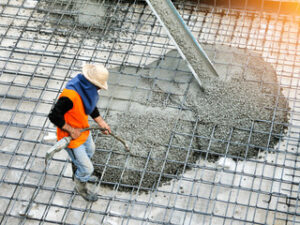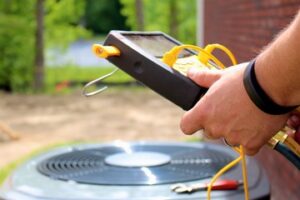Concrete Contractors specialize in building construction projects with concrete. They have a passion for their craft and take pride in the quality of work they produce.

Finding a good concrete contractor begins with research. A simple online search can generate a list of contractors in your area. You can also ask friends, family and business associates for referrals.
Concrete contractors are the people who make construction projects come to life. They take the plans and specifications from the design team and turn them into a physical reality. Their expertise and craftsmanship ensure that the project runs smoothly from start to finish.
When choosing a concrete contractor for your next commercial project, it’s important to choose someone who has the experience to complete the work safely and accurately. Look for contractors who have a long history in the industry, and ask for references from past customers. Talking directly to past clients gives you a more complete picture of the contractor’s professionalism and quality of work. Ask for details about the project, including how the contractor kept to schedule and budget, and what their overall experience was like.
The first step in a concrete project is site preparation. This includes cleaning and clearing the area, preparing the base, and placing forms to prevent concrete from escaping during the pouring process. It’s also important to prepare the concrete mix in advance, and have enough material on hand to meet the project’s requirements.
Once the forms are in place, concrete contractors can begin to pour the concrete. They carefully monitor the mixing process, adjusting it as needed to guarantee strength and durability. Once the concrete is poured, they use tools like screeds and trowels to smooth the surface and eliminate air pockets. They can add textures or patterns to the concrete during finishing, and they often use sealants to protect the concrete from stains and enhance its durability.
Finally, concrete contractors must also be able to manage the curing process. This involves keeping the concrete moist to promote strength development and prevent cracking, and using techniques like wet curing and curing compounds.
They Pour the Concrete
When concrete is poured, it’s a wet substance that needs to be handled carefully. This is where the concrete contractors’ expertise comes into play. They can use specialized tools and equipment to ensure the quality of the concrete and its structural integrity.
They also have a deep understanding of the material’s properties, construction techniques, and building codes. They must also be able to assess environmental considerations and weather conditions to determine the best course of action for the project.
The first step is preparing the site, which includes assessing the soil to make sure it can support the concrete. Contractors must also consider factors like slope and drainage to avoid issues like cracking or shifting. They also plan out the layout and dimensions of the structure to ensure it will be functional and aesthetically pleasing.
Once the form is set and the site prepared, the concrete mixing and pouring process begins. Concrete is a mixture of cement, water, and sand or aggregates, and the precise proportions are critical to achieving the right strength and durability for each job. Commercial concrete contractors keep up with the latest developments in admixtures and additives to ensure they’re using the best mix for each project.
When choosing a concrete contractor, ask about their experience and past projects. They should be able to provide you with a list of references, and it’s also helpful to visit some of their previous work. Also, when asking for an estimate, be sure to get the square foot price. Most concrete suppliers have their prices listed online, so you can compare quotes before making a decision. Also, be sure to factor in any permit or approval requirements that may affect the timeline of your project.
They Finish the Concrete
Concrete is an essential construction material that plays a crucial role in shaping our communities. It’s used in a wide variety of structures, from sidewalks and driveways to foundations for skyscrapers and homes. But it’s not easy to work with, as it requires expertise and precision. Enter concrete contractors, specialized professionals who handle all aspects of concrete projects. They work with architects, engineers, and other construction experts to ensure that the concrete meets the specifications of the project. And they use a variety of techniques to finish the concrete, enhancing its aesthetics and durability.
The first step in the process is preparing the site. This might include clearing debris, leveling the ground, or establishing forms and molds that shape the concrete. Contractors also mix the concrete according to the project’s specifications. This process involves assessing the right proportions of cement, water, and aggregates to ensure the final product is strong and durable.
Once the concrete is poured, contractors use tools like trowels and floats to achieve the desired texture and smoothness. They may also apply a sealant to protect the concrete from moisture, stains, and wear. The curing process usually lasts several days to weeks, depending on the type of concrete and environmental conditions.
When choosing a concrete contractor, it’s important to look for a few key qualities. The most important is experience. Contractors with years of experience have likely worked on a variety of projects and know how to navigate challenges that may arise during the construction process. They’ll be able to offer helpful advice and guidance that will keep the project on track and within budget. It’s also a good idea to ask contractors for references and a portfolio of past work. This will help you get a feel for their quality of work and level of professionalism.
They Cure the Concrete
Once the concrete has been poured, it needs to cure for seven days. Curing is an essential step because it prevents in-situ concrete from drying, shrinking, and cracking. It also helps the cement crystals hydrate and reach their maximum design strength. Careful monitoring of temperature and moisture is key during the curing process.
Improper curing causes problems like premature removal of forms and supports, low-developed concrete strength, and reduced durability. A lack of water due to evaporation is the most common problem during curing. It is important to maintain a constant level of moisture over the concrete surface, and use methods like ponding, sprinkling, or wetting with a special fabric to keep it moist.
Using materials that retain moisture for long periods of time, such as plastic sheets or wet burlap, is ideal for concrete curing. Moisture-retaining covers also protect the concrete from wind, sun, and debris and help to regulate the air temperature, which is critical for hydration.
A concrete contractor may also utilize insulating blankets or heating systems to accelerate curing in cold weather and prevent freezing, while maintaining the proper temperature for optimal hydration. In addition to enhancing the autogenous healing process in concrete, this type of curing method reduces energy consumption and environmental impacts.
Avoid stacking heavy objects or pallets against the concrete slabs while they are curing. This can cause damage to the surface and, in the worst cases, even the structure beneath. Similarly, do not walk on or drive over the concrete while it is curing. The vibrations could crack it or cause it to shift, which could affect the structural integrity of the project. A concrete contractor should know whether the site has any requirements for specific curing techniques.
They Repair the Concrete
Concrete contractors help bring construction visions to life, and they are a key component in the process. These skilled tradespeople use their expertise and experience to complete all aspects of concrete work on a variety of projects, including foundations, slabs, walls, and other structural elements.
One of the most important responsibilities of a concrete contractor is planning and designing projects before they begin. This involves interpreting blueprints and drawings to determine the specific specifications and requirements of concrete construction. It also includes collaborating with other construction professionals to ensure that concrete work seamlessly integrates with the project’s design and structural integrity.
Once the concrete has been poured, concrete contractors carefully smooth and finish it to achieve the desired texture and appearance of the finished product. This is a highly skilled process that requires a great deal of attention to detail. Concrete contractors also use various techniques to ensure that the concrete is strong and durable.
If the concrete needs to be repaired, a concrete contractor will evaluate the problem and determine the best solution. This may include injecting epoxy into cracks, patching with mortar, or using prestressed steel to add a compressive force to weak areas of concrete. They will then use tools to repair the concrete and clean up the area.
When choosing a concrete contractor, it is essential to find one with experience and a good reputation. A professional will be able to complete the job more quickly and efficiently, saving you money on labor costs. They will also have a better understanding of the industry and know which strategies work best. You can find out more about a concrete contractor’s reputation by asking them for references from previous customers and contacting them to discuss their experiences.


